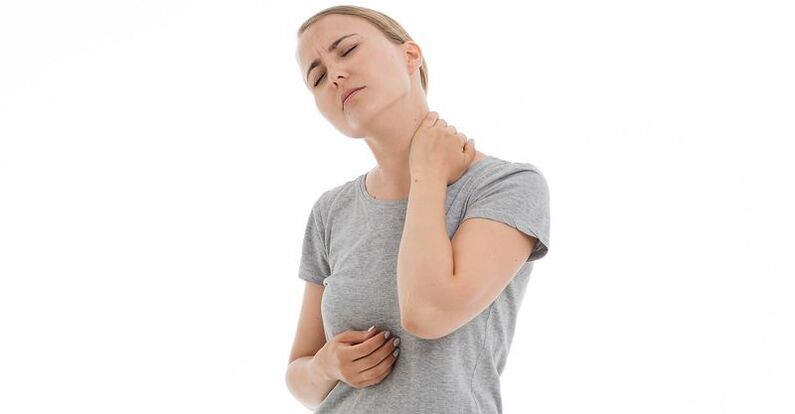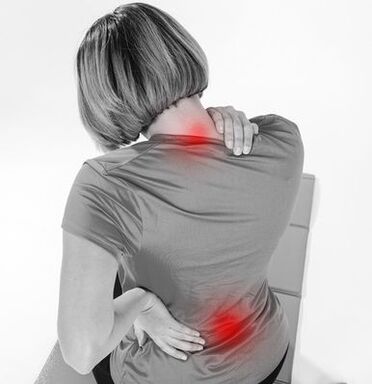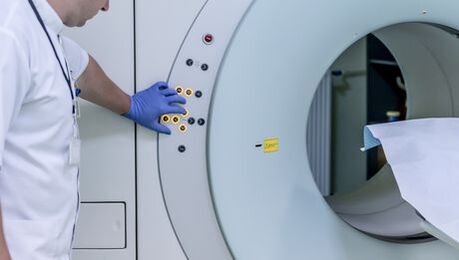
Do you feel the back pain and numbness of the limbs?These are the first signs of osteochondrosis.Inadequate lifestyle mobility, sitting work, the neck and spine load leads to the fact that cartilage gets in and loses moisture as a result of which they are damaged.
With cervical osteochondrosis, degenerative changes in intervertebral discs occur.Not only are the discs subjected to damage, but also the vertebrae and joints in the cervical region.If you do not treat the disease for a long time, the patient's overall health worsens: constant headaches, the appearance of vertebrates, the deterioration of brain circulation as a result of which cognitive functions are reduced.
The reasons for the development of osteochondrosis
An incorrect sitting position in which the neck extends forward leads to the development of a cervical disease.In this case, excessive pressure on intervertebral discs occurs, which leads to changes in the pulpous nucleus and squeezing the blood vessels.This position is a person who occupies at the workplace in front of the computer.Therefore, office workers are more often subject to the development of cervical spine osteochondrosis.

In addition, the causes of pathology development can be:
- Inadequate load distribution when using bags;
- an excessively soft place (the spine is doubled in an unnatural form);
- genetic predisposition;
- Lack of vitamins and tracking elements in the diet;
- Endocrine system disorders;
- Spinal curvature and violation of posture during active body growth;
- Cervical vertebra lesions;
- The presence of bad habits.
Disease stages
To determine whether their symptoms of pain are signs of the development of cervical spine osteochondrosis and that stage of disease development can only be determined by an experienced doctor after examination and palpation.In total, cervical osteochondrosis passes four stages of development:
- Pulposus nucleus - The central part of the intervertebral disc in the first stage is subjected to moderate dehydration.As a result, the support and shock absorption functions of intervertebral discs are gradually lost.In the first step, you will feel pain with sudden movements, hypothermia and will be in a pose for a long time.
- The second stage of development is characterized by the appearance of stagnant phenomena and spasms that squeezed the capillaries and blood vessels, preventing normal blood circulation.As a result, the intervertebral disc condition is thinner, forming the property (protruding forward or backward).Under the influence of excess load on cervical vertebrae, osteophytes are formed.The sensations of pain are located in one place, with sharp curves and inclinations of the head, there may be dislocations of the cervical vertebrae.
- Extrusion is formed as a result of intervertebral disc thinning.The edge of the pulp core breaks the fibrous ring and goes beyond the edges of the vertebral body.The muscles and nerve endings are squeezed.It is felt by pain in the neck, back and limbs.
- In the fourth stage of the disease, intervertebral discs are displaced and formed by central and side hernias.In addition, scars are formed on discs, which leads to the immobility of the affected joint.The patient experiences constant back pain, which is given to other parts of the body, there is a constant feeling of fatigue, the asymmetry of parts of the trunk.

Cervical osteochondrosis symptoms
The symptoms of cervical spine osteochondrosis manifest differently, depending on the stage of development of the pathology.In the early stages, it may occur virtually without the presence of signs.Pain in the neck and back may appear only in case of prolonged stay in a pose, clear slope or spin.
In later stages of development, a spine crisis is heard, back pain is given to other members, there is numbness of body parts.With the formation of osteophytes and extrusion, there are:
- headaches on the back of the head and parietal part;
- Speech impaired and numbness of language;
- decreased sensitivity of neck skin;
- respiratory disorders;
- Blood pressure oath;
- heart disorders;
- noise and stagnation in the ears;
- Fainting.
The symptoms of cervical spine osteochondrosis in women are much more pronounced than in men.This is due to the fact that women are predisposed to vascular diseases and a more fragile structure of the bone segments of the spine.Signs of the disease begin to appear when changes in the intervertebral disc occurs.This leads to a violation of normal blood circulation and causes serious headaches, dizziness and neurosis.An exacerbation of the disease in women often occurs during menopause when the body is subject to changes in a hormonal background.
The symptoms of cervical osteochondrosis in men are similar to the female, erectile dysfunction can be observed separately.
Headache for cervical osteochondrosis is caused by circulatory disorders in the brain and spinal cord.When the vertebrae change, they tighten the arteries and the oxygen content in the blood decreases.Unfortunately, this pain may not pass even after taking strong painkillers.Therefore, it is important to address the solution of the problem comprehensively.The dizziness of cervical osteochondrosis can be accompanied by darkening in the eyes, the appearance of noise in the ears.This is because spasmned muscles cause a reduction in oxygen access to the brain.
A lump in the throat with cervical spine osteochondrosis, as well as burning, difficulty breathing and muscle cramps - this is a common occurrence.The disease causes the nerve fibers of the cervical spine in the head and neck.Nerve impulses disorders cause sore throat.
Due to spasms of the blood vessels and irritation of nerve endings, heels occurs in blood pressure.Increased lower pressure in osteochondrosis indicates that blood supply to individual areas of the brain is disturbed, as the vertebral artery is survived by intervertebral discs.As a result, oxygen hunger and blood pressure increases.

How is the diagnosis of osteochondrosis of cervical spinal osteochondrosis?
The diagnosis of pathology begins with a specialized consultation.In the first demonstrations of osteochondrosis, contact the rheumatologist, neuropathologist, surgeon or traumatologist-orthodist.The doctor will ask about the symptoms and frequency of their manifestation, it is necessary to provide the specialist the complete history of the disease and the results of the first studies (if any).The expert will conduct an inspection and visual palpation, will direct -to tests.The doctor during the examination provides special attention to neck mobility, muscle tone, skin sensitivity and reveals the most painful areas.
To identify the condition of the muscles, ligaments, blood vessels, to detect inflammatory processes or tumors, an informative and secure diagnostic method of the cervical spine is prescribed.The patient during Magnetic Resonance Osteochondrosis is at a special retractable table with the back.Roliks are placed on the patient to the patient to remove muscle tension and the limbs are fixed with belts.Any insignificant movement during the procedure can affect the quality of the result.Then the table for tomography.The procedure does not cause pain.Tomography makes a heavy noise during scanning so you can use the headphones so you don't feel discomfort.
If the magnetic resonance imaging is against -indicated, there are other diagnostic methods, such as computed tomography and radiography.The -x radius is adequate only for primary diagnosis and does not provide a -in -in -so -on -tissue -in -layer image.However, this study is the simplest and most economical, allowing to explore the patient's body in various projections.Due to the strong body radiation load, radiography cannot be performed frequently.
During computed tomography, the scan is performed using one or more bundles of yoning ray.They pass through the human body and are recorded by the detectors.Detectors move along the patient's body in opposite directions and fixed at 6 million signs.Different tissue density with a precise determination of the boundaries of the affected organs and areas in the form of a section are displayed in the image.The procedure allows you to get a layer image.

Treatment of cervical spine osteochondrosis
How to treat cervical osteochondrosis, only a doctor will determine after examination, studying medical history and obtaining the results of hardware diagnosis.If the disease has been diagnosed at an early stage, treatment will undergo conservative ways.In the treatment of osteochondrosis, it is important to adhere to an integrated approach - take medications, engage in physical therapy, go to therapeutic massage and avoid heavy physical effort.
First of all, you need to stop the pain.For this, painkillers and local action painkillers are prescribed.With strong muscle cramps, they are prescribed to use an orthopedic necklace.After pain syndrome was eliminated, it is necessary to interrupt the inflammatory process and restore normal blood circulation.For this, antioxidant and anti -inflammatory therapy is performed.As additional measures, therapeutic exercises and swimming are prescribed.You can get involved in physical education, both at home and with a coach.
If osteochondrosis becomes severe, the doctor may prescribe surgical intervention.The operation uses rare cases when the pathology develops against the background of other diseases - scoliosis, intervertebral disc hernias, curvature or displacement of the spine, lesions.
Treatment of cervical osteochondrosis in women is not particularly different from men's treatment.However, doctors usually recommend women to make external compresses to heat and strengthen the neck muscles.
Experts recommend from early childhood to avoid various back diseases.To do this, you need to form the correct posture while walking and stays in the desktop.Complete nutrition and proper strengthening of the back muscles will help to avoid negative consequences in the future.



































